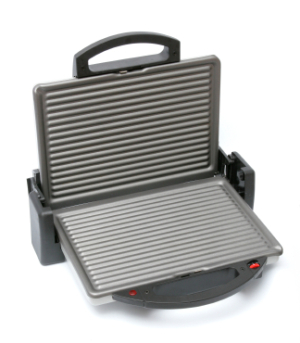Eight (8) Reasons Products Sit on the Retail Shelf

Grills like this were on the shelf for nearly 20 years before communication made a breakthrough
Grills nearly identical to George Foreman’s lingered on store shelves for nearly 20 years. Then, the Foreman infomercial blew the doors off driving over $100M in sales in two years. And we learned that while the Grill delivered tremendous value to consumers, no one had known of those benefits or believed it would deliver them.
Not all Shelf Potatoes have potential like the Foreman Grill. Some sit on the shelf because they should. Contributor Ben Smith has noted that the Microsoft Kin was released with massive communication, failed to show unique value, then lingered on the shelf only to be cancelled leaving a black spot on Microsoft’s reputation.
How can you tell whether you have a Foreman Grill, a Kin, or something in between? Start by identifying the problems that keep it on the shelf. Here’s a list of the most common types of problems I’ve seen.
1. Consumers don’t know why they should care about the product. We all have busy lives. And successful manufacturers reach out to consumers to show the value of the product through advertising and PR. It’s an extraordinarily rare product that walks out the door when you do no more than put it on the shelf.
2. Consumers won’t find out about the product in their daily grind. We live by patterns. Patterns as we move through a store. Patterns in how we live at home. New products must worm their way into our minds despite the fact that patterns often present a barrier. And that means communication that reaches out to consumers off-line. Be wary of pure online plays. These patterns are notoriously resistant to efforts to reach out with web based initiatives.
3. The product is stocked in the wrong part of the store. Some shelf potatoes can be brought to life merely by moving them from one spot to another. A friend of mine had tremendous impact moving certain food products out of the spice and baking aisle and locating them with the fresh vegetable section. We’ve all seen cases like this. And yet it’s easy for products to sit in the wrong place when we fall back on rigid category thinking that is confirmed by the common silo’s found among retail buyer’s.
4. The retail operation can’t support the product. In mass retail, marketing must plan that most sales associates are so overloaded with products that the most you can hope they know is that your product exists and where someone can find it on the shelf. So if you have a complex product, like I discussed in my WebTV post, it’s your job to find clever ways to drive consumer demand.
5. Your packaging isn’t helping – and might even be hurting. Ah, packaging. Too often we ask too much of it. And ironically, too often we ignore the opportunity to use it for communication. While ad agencies often aren’t the right teams to design packaging, perhaps you should bring them together with your internal or external designers so that all of your communication gains power through integration.
6. Sitting on the shelf, the price appears high relative to the value consumers perceive. You can respond in several ways. Obviously, you could choose to decrease price. But the best long term benefits come through other approaches. How can you increase awareness of the products value – thereby increasing the price people will pay?
7. The product started well and lost momentum. This excellent post from RetailLeverage discusses important steps for maintaining momentum. For example, “Keep the exact product on the shelf for as long as possible.” (I’m reminded of a corresponding truth about advertising: Companies grow tired of their advertising long, long before it loses its effectiveness with consumers.)
8. And of course, there’s the ultimate problem: The product simply doesn’t offer enough consumer value. In this case, it’s better to cut your losses.
Aren’t the solutions to these problems expensive? None of the problems can be solved for free. Otherwise, the products wouldn’t be sitting on the shelf. But unfortunately, this fear of costs can lead companies to abandon Shelf Potatoes.
In marketing discussions, companies often minimize the development costs and exceptionally high risks in a new product development. So their fear of costs for shelf potatoes isn’t balanced by an accurate sense of the costs and risks of new product investment. Because redeeming a shelf potato be much less expensive, lower risk, and carries a much higher potential profit reward.
And this makes it fun to wander the back store rooms of manufacturers talking with them about their potatoes. Because some of their biggest potentials for high profit margins are already sitting on the shelf.
Copyright 2010 – Doug Garnett
Categories: Advertising, Consumer Electronics, consumer marketing, Innovation, Retail, technology marketing
Sorry, comments are closed for this item.

